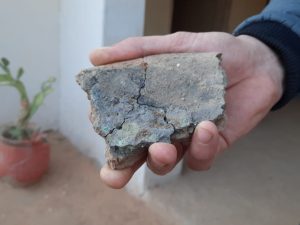We’ve had a busy 10 days on the excavation! We had two documentary crews filming and interviewing us for about half that time–stay tuned in the coming year for those shows, which should be interesting.
We have started clearing more of the long street through the heart of the settlement that we had identified last season (here’s a reminder photo):

Last year we exposed about 60 meters of the street and this year so far we have opened up three new trenches along the line of the street. We are developing a theory of what this street could be and I will write more about that if we get a little bit more support from the excavation. But for now I want to highlight evidence for manufacturing copper objects that we’ve been finding.


We did not find these fragments in place where they were originally used, or even in a trash deposit where they had been discarded, but rather just in “fill”–what archaeologists call a tertiary deposit. That means that we don’t know exactly where the smelting was happening, but we do know it was going on in the city. But that is a surprise at some level. Ancient Kush has never been known as having relied significantly on copper smelting (in part because they did not have easy access to tin that could be mixed with the copper to make bronze) and it is not clear where the sources of the copper might have been. The sherds date to the earlier part of the Meroitic period (3rd c. BCE to 1st c. CE).
I have a museum colleague who said she fell asleep a little bit every time I said the word “metallurgy” (hi Swarupa!). But these finds show that we’re getting closer to identifying the workshops of the ancient city, which is exciting!

